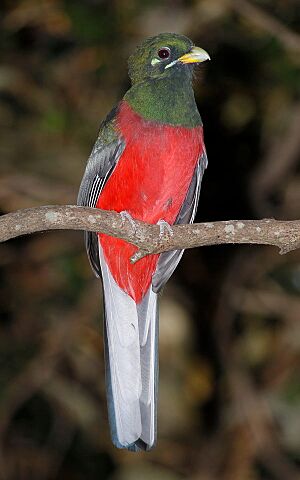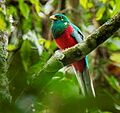Narina trogon facts for kids
Quick facts for kids Narina trogon |
|
|---|---|
 |
|
| Adult male in South Africa | |
| Conservation status | |
| Scientific classification |
The Narina trogon (Apaloderma narina) is a beautiful, medium-sized bird, about 32–34 cm long. It belongs to the Trogonidae family. These birds are mostly green and red. You can find them in forests and woodlands across Africa.
Even though the Narina trogon lives in many places and different types of habitats, its numbers are getting smaller in some areas. This is mainly because of deforestation, which means forests are being cut down. Some Narina trogons stay in one place all year, while others move around regularly.
What They Look Like
Narina trogons look different depending on if they are male or female. This is called being "sexually dimorphic." Males are usually much brighter in color.
Both male and female Narina trogons have bright, greenish-yellow feathers on their upper bodies. Their tail feathers shine with a metallic blue-green color. The outer three tail feathers on each side have white tips and edges. This makes the underside of their tail look white when they are perched. Their wing feathers are mostly gray.
The male Narina trogon has a bright red belly. It also has bare, green skin around its mouth and eyes. The female has brown feathers on her face and chest. The skin around her eyes is blue, and her red belly feathers are not as bright as the male's. Young birds look similar to females. However, they have clear white tips on their inner wing feathers. Their skin around the mouth and eyes is also less noticeable.
Where They Live
The Narina trogon lives in a very large area across Africa. You can find them in forests from lowlands to highlands. They also live in forests near rivers. They can be found in tropical areas and cooler, temperate regions. Birds that live in high mountains sometimes move to lower areas during certain seasons.
Their range stretches from Sierra Leone in the west to Ethiopia in the east. They also live from east Africa all the way down to eastern and southern South Africa. Because they live in so many different places and habitats, the Narina trogon is not considered to be in danger of extinction.
Their Habits and Nests
Narina trogons mainly eat insects and small invertebrates, which are creatures without backbones. They also sometimes eat small rodents and reptiles.
When a male Narina trogon calls, it makes a low, repeated hooting sound. They do this to protect their territory or to attract a mate. When calling, the male expands the bare, blue-green patch on its throat. Both males and females might fluff out their chest feathers as a display.
Narina trogons build their nests inside a tree hollow. Both the male and female birds take turns sitting on the eggs to keep them warm. They also both help to care for the young birds after they hatch.
Images for kids




